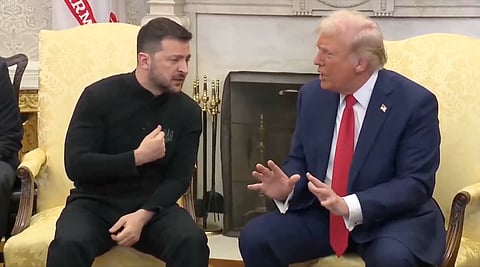

U.S. President Donald Trump met with Ukrainian President Volodymyr Zelensky on the sidelines of the NATO summit in The Hague on Wednesday, as European leaders scrambled to persuade Trump to re-engage with Ukraine.
This marked the first meeting between the two leaders since their contentious Oval Office encounter on February 28th, during which Trump reportedly ordered Zelensky to leave the White House.
In a noticeable shift from his usual attire, Zelensky arrived at the summit on Tuesday wearing a formal black coat—departing from the military-style clothing he has worn since the Russian invasion began in 2022. The wardrobe change may have been an attempt to appease Trump, who had previously insisted that Zelensky and his aides wear suits and ties to their February meeting—an instruction Zelensky ignored at the time, prompting a public rebuke from the U.S. president.
Despite describing the conversation as “long and substantive,” Zelensky appears to have left the meeting without securing any new funding or significant commitments. Trump reportedly only promised to “consider” sending additional Patriot missile systems to Ukraine.
Zelensky, who has recently appealed for $40 billion in annual funding from G7 nations and urged NATO countries to commit 0.25% of their GDP to Ukraine—amounting to roughly $175 billion—did not secure new financial pledges at the summit.
Notably, the NATO-Ukraine Council, which has convened at every summit since 2022, did not meet this year. Ukraine’s diminished prominence on the summit agenda reflects Trump’s desire to scale back U.S. involvement in European affairs.
In contrast to past summits, where Ukraine was the central focus, this year’s gathering emphasized increased defense spending by NATO member states. According to Hungarian Prime Minister Viktor Orbán, Zelensky was excluded from key alliance meetings and relegated to informal bilateral talks.
Reports also indicate that the final summit communiqué will be significantly shorter than in previous years and will omit any reference to Ukraine’s NATO membership aspirations—a sharp departure from the bloc’s earlier stance and a possible sign of acquiescence to Trump’s reluctance to deepen U.S. entanglement in the conflict.